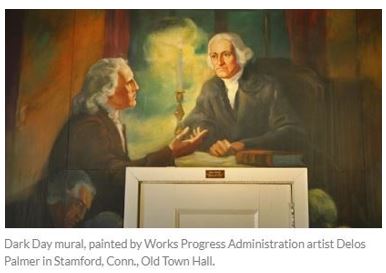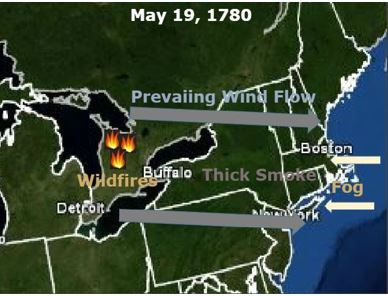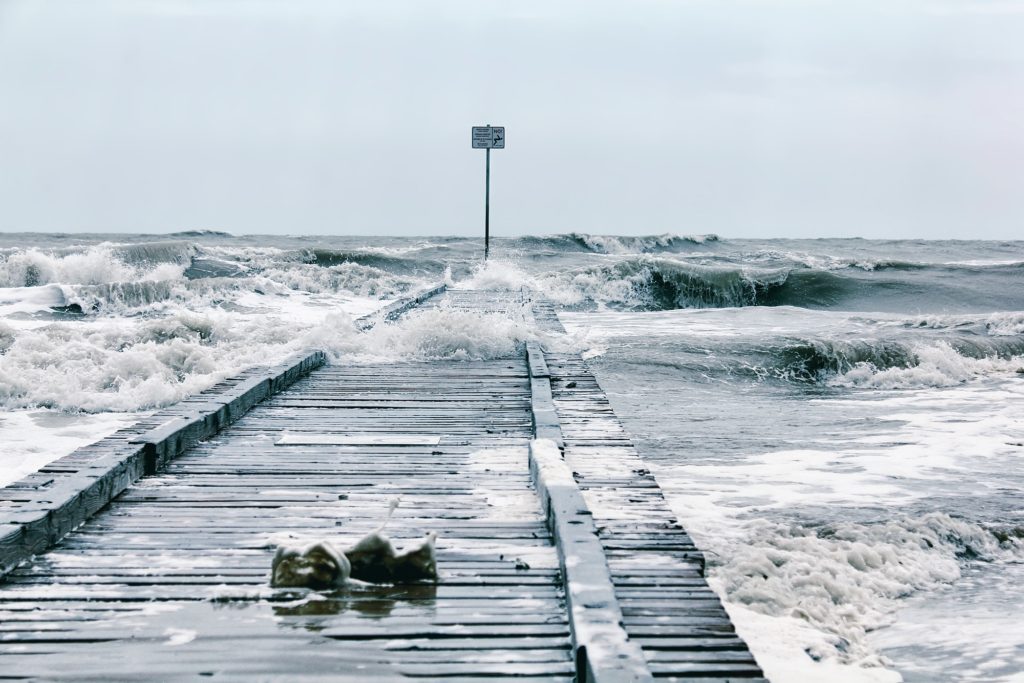During much of the spring of 1780 things looked quite normal across the skies of what is now called the northeastern U.S. As April turned to May, many townspeople noticed colorful sunsets of red, yellow, and orange. On Friday, May 19th, the sky darkened and the morning suddenly became more like nighttime. There was no eclipse of the sun. Residents of the region became fearful that the end of the world was commencing. Others were just bewildered. The cause of this strange phenomenon is the topic of this story.
Daytime Darkness
The occurrence I just described is often called “New England’s Dark Day”. The darkness extended to parts of New York and down to New Jersey. The morning became darker and darker, especially near the East Coast. By midday, it was so dark, that candles were needed to see.
In the publication “The Adventures Of A Revolutionary Soldier” Chapter Vi Joseph Plumb Martin recalled the following :
We were here [New Jersey] at the time the “dark day” happened, (19th of May) it has been said that the darkness was not so great in New Jersey as in New England. How great it was there I do not know, but I know that it was very dark where I then was in New Jersey; so much so that the fowls went to their roots, the cocks crew and the whip-poor-wills sung their usual serenade; the people had to light candles in their houses to enable them to see to carry on their usual business; the night was as uncommonly dark as the day was.
The Revolutionary War was ongoing and General George Washington was stationed at an army headquarters at Morristown, New Jersey. Here’s what he wrote according to an article in New England Historical Society.com :
Heavy & uncommon kinds of Clouds–dark & at the same time a bright and reddish kind of light intermixed with them–brightening & darkening alternately. This continued till afternoon when the sun began to appear. The Wind in the Morning was Easterly. After that, it got to the Westward.
In Rupert, Vermont the sun was already obscured as it rose.
In Massachusetts, Professor Samuel Williams at Harvard University wrote the following:
“This extraordinary darkness came on between 10 and 11 am and continued to the middle of the next night”.
The darkness was reported to have arrived around 10:30 a.m. and peaked around 12:45 p.m. but a gray overcast continues for the rest of the day.
The darkness was reported up to Portland, Maine.
Panic And Bewilderment
The “Dark Day” was filled with panic and confusion among residents of the Northeast. Thousands left their workplace and went to the churches to pray, fearing that the end of the world was near. Others rushed to taverns so they could drink to reduce anxiety. Children were released from school.
Animals reacted to the strange day, as well. Chickens went to their roosts, cows paraded to their stalls, night birds chirped and frogs peeped. It was as if morning suddenly jumped ahead to midnight.
A strong sooty smell wafted in the air and black scum floated on the rivers.
 Many members of the Connecticut Legislature feared that “Judgement Day was upon them and they must adjourn. According to the publication “Legendary Connecticut” one member, Abraham Davenport responded to his colleagues’ fears.
Many members of the Connecticut Legislature feared that “Judgement Day was upon them and they must adjourn. According to the publication “Legendary Connecticut” one member, Abraham Davenport responded to his colleagues’ fears.
“I am against adjournment. The day of judgment is either approaching, or it is not. If not, there is no cause for an adjournment; if it is, I choose to be found doing my duty. I wish therefore that candles may be brought.”
The great poet, John Greenleaf Whittaker, wrote a poem about the “Dark Day” and he referred to the courage of Abraham Davenport.
‘T was on a May-day of the far-old year
Seventeen hundred eighty, that there fell
Over the bloom and sweet life of the Spring,
Over the fresh earth and the heaven of noon,
A horror of great darkness, like the night In a day of which the Norland sagas tell, — The Twilight of the Gods.
And there he stands in memory to this day,
Erect, self-poised, a rugged face, half seen
Against the background of unnatural dark,
A witness to the ages as they pass, That simple duty hath no place for fear.
Eighty years later, Senator John F. Kennedy referred to the “Dark Day” and praised the courage of
Abraham Davenport during a presidential campaign speech in North Carolina. Here are his words:
“I hope in a dark and uncertain period in our own country that we, too, may bring candles to help light our country’s way”.
Atmospheric conditions improved through that evening and overnight hours. Here is an account of conditions that evening:
The wind in the evening passed round further north where a black cloud lay, and gave us reason to expect a sudden gust from that quarter: The wind brought that body of smoke and vapor over us in the evening (at Salem) and perhaps it never was darker since the children of Israel left the house of bondage. This gross darkness held till about one o’clock although the moon had felled but the day before.
Between one and two the wind freshened up at north-east, and it drove the smoke and clouds away which had given distress to thousands, and alarmed the brute creation.”
At that time, the moon was seen shining brightly. The next day was bright and sunny and all was well once more.
What caused this mysterious atmospheric phenomenon that confused some and made others panic? The “Dark Day” was actually connected to a large forest fire which was burning in Ontario, Canada.
Meteorological Conditions
Scientists found charcoal and resin scars in tree rings in the Algonquin Highlands of Ontario. This area lies between Georgian Bay and the Ottawa River. Today, much of this area is included in the Algonquin Provincial Park.
The tree ring scars are indicative of a large wildfire that was burning in the area during the period in question. On May 19, 1780, there were reports of prevailing wind flow from the west or west-northwest. This was likely the prevailing flow aloft, as well.
As indicated earlier, surface winds over eastern New England were from the east during the morning hours and the fog rolled in from the Atlantic.
Atmospheric conditions in the Northeast on the “Dark Day” May 19, 1780. Note – Detroit was not incorporated as a city at that time, nor was Buffalo.
The prevailing wind sent smoke from the wildfires toward what is now the northeastern U.S. and turned the sky eerily dark. The fog probably made the scene even darker. The soot that was observed had fallen out of the sky. In some areas, rain showers had come down, which explains why soot was observed on rivers and ponds.
I wasn’t able to find any temperature observations but I suspect that the clouds of smoke kept temperatures several degrees lower than they would have been.
In the days preceding May 19th, the winds were blowing in a direction that brought some smoke and haze into the Northeast U.S. On “Dark Day’ the prevailing wind flow was in a perfect direction to send the smoke toward the East Coast. A change in surface and upper-level winds during the evening and overnight hours transported the smoke away from the affected areas, allowing the sky to clear.
Fortunately, our understanding of our surroundings and the physical world has come a long way since then.




